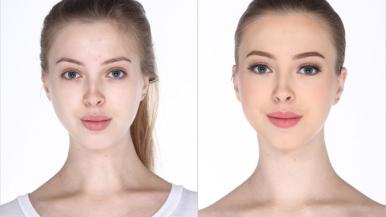In a 2019 project called "Selfie Harm," British fashion photographer Rankin took portraits of 15 teens and asked them to edit their photos to make them "more social media-ready."
Although the majority of the teens said they actually preferred their original, unretouched photos, every single one chose to digitally alter their image for social media. Many made themselves unrecognizable, even cartoonish, drastically changing the shapes of their noses, eyes, chins and/or lips, as well as adding dramatic makeup and smoothing out their complexions.
You might call it the Kardashian effect. Our social media feeds are filled with images of "perfect" celebrities and influencers with plumped-up lips, Botoxed skin, augmented breasts and backsides, and sculpted waistlines.
Many of these images are also retouched or use filters — creating looks that are unattainable in reality, but that nonetheless define the standards of beauty that girls and women measure themselves against.
Consequences of the quest for ‘perfection’
Unfortunately, this pressure to look flawless in selfies on social media isn't just keeping Photoshop in business. It's also driving more and more people — including a number of teens and twenty-somethings — to alter their actual appearances. Consider these stats from the American Society of Plastic Surgeons:
- 18.1 million cosmetic procedures were performed in the U.S. in 2019, up from 17.7 million procedures in 2018. This includes 16.3 million minimally invasive procedures (which saw an increase of 2% over 2018).
- Americans had more facelifts, eyelid surgeries and liposuction in 2019 than 2018, and there were sizeable increases in buttock augmentation (17%) and labiaplasty (9%) as well.
- Facial rejuvenation procedures have become increasingly popular; 2019 saw the highest number of botulinum toxin injections to date (nearly 7.7 million — 300,000 more than in 2018).
- More than 1 million procedures were performed on patients ages 13 to 29.
And even more evidence points to social media as a major reason for these trends. In a 2018 report by the ASPS, more than 40 percent of plastic surgeons say looking better in selfies on Instagram, Snapchat and Facebook is an incentive for patients of all ages to seek both cosmetic surgery and nonsurgical enhancements like Botox and fillers.
We asked RUSH plastic surgeon Amir Dorafshar, MD, and RUSH psychiatrist Monica Argumedo, MD, to offer advice for anyone thinking about altering their appearances because of what's being called "social media dysmorphia."
They offered the following recommendations:
1. Set realistic expectations.
While cosmetic surgery and nonsurgical procedures can change your look, there are limits. In other words, you can bring a photo of Beyonce to the surgeon, but don't expect to end up looking like her twin.
"A patient’s cosmetic journey starts with a consultation — a discussion between the patient and the surgeon. They tell me what they are not happy with, or if they don’t know exactly what they want, I ask questions to help them articulate what they are looking for,” Dorafshar says. "My goal is to understand what they are seeking and see whether I can help them get to where they want to be, but at the same time to help them realize what is actually attainable based on their individual form and structure.”
During consultations with patients, Dorafshar is candid about what can be achieved with cosmetic treatments. "I want my patients to feel like they came in and I listened to them and gave them my expert advice based on my experience,” he says. "The problem is when the request is unreasonable or when a person is not being realistic about what’s possible. In those cases, I have to tell them I’m not the right surgeon for them."
2. Weigh the financial costs.
Cosmetic procedures aren't cheap, and they're not covered by insurance unless they are deemed medically necessary. For instance, liposuction and CoolSculpting both run $2,000 to $4,000 per treatment area, not including fees for the operating room and anesthesia. A tummy tuck procedure will set you back $5,000 to $9,000.
Facial rejuvenation procedures don't offer lasting results, so even seemingly inexpensive treatments can add up over time. Juvederm, a popular dermal filler, runs around $500 to $900 per syringe, and depending on the area being treated you may need more than one syringe per session. The results last around one to two years.
You Might Also Like
How the Pandemic May Have Increased Demand for Cosmetic Procedures
"Botox and fillers are just going to be temporary measures," Dorafshar says. "You have to keep using them to continue getting results. So you need to really think about whether you're willing and able to spend that much on cosmetic procedures for long-term maintenance."
If you're the parent of a teen who's asking you to pay for cosmetic procedures, don't be afraid to explain that cosmetic surgery simply isn't in the family budget.
You can also tell them if they want enhancements, they'll have to use their own money. The time it takes to save up will give them time to think about whether they really want this change — and they may even grow out of that phase.
Of course, as with any type of surgery, parental consent is required for anyone under the age of 18. So even if money isn't an issue, if your child is underage, it's ultimately your decision.
3. Consider how changes will look and feel in real life.
Often, what looks good in a selfie doesn't look good in real life.
For example, Dorafshar sees a lot of young women who want lip fillers because plump lips are trendy. "I always start with a reasonable amount of filler and ask the patient to live with it for a bit and see how they like it," he explains. “You have to give the filler time to settle in before you can see how your lips will truly look. You can always add more if you aren’t happy with the results.”
The same proceed-with-caution approach is true for breast augmentation. Getting implants that are way too large for your frame can cause a range of problems — from back pain to difficulty exercising to trouble finding clothes that fit properly.
“It’s also important to consider how the breasts fit into a person’s overall body aesthetic,” Dorafshar says. “It’s all about creating a harmonious appearance: Whether you want larger breasts or smaller, you want to make sure your breasts are an appropriate size and shape for your body.”
3. Recognize that 'beauty' is ever-evolving.
"If you change your appearance every time you're dissatisfied, you'll always be disappointed because societal standards will always change," Argumedo says. "In two years, people will say, 'We were into that two years ago. Now we're into something else.' It takes away from the value of you as a human being to keep trying to morph into someone else."
Standards of beauty aren't the only thing that change over time: Our features change as we mature. You don't look the same at 45 as you do at 18, or at 75 as you do at 45.
And regardless of how much cosmetic surgery you have, it's impossible for most people to completely combat the effects of aging. All you have to do is Google "bad plastic surgery" or watch "Botched" to see examples of people who took it too far in their quest for eternal youth.
"You may experience aging-related changes that you don’t like — deep wrinkles or loose skin, for instance — and want to address,” Dorafshar says. “But you need to also accept that the aging process continues regardless of what you do and not go to extreme measures trying to look ‘perfect.’ Think of cosmetic procedures as a way to look like your best self at every age, rather than a fountain of youth.”
4. Focus on loving everything about yourself.
When you look back on your life, what you remember isn't your appearance — it's your family and friends, career and experiences. The same is true of your loved ones. What you love about them is who they are, not how they look.
"You are never valued just for your physical appearance," Argumedo says. "So it's important to put everything into perspective instead of obsessing over your self-image." She recommends asking the following important questions:
- What are you good at?
- What are your passions?
- What kind of person are you?
- How do you treat others?
Argumedo practices what she preaches: She’s teaching her own children to be themselves, and to love what's unique about them instead of always comparing themselves to others.
"You're the only person like you, and everyone is beautiful and special in their own right," she says. "And keep in mind that people post on social media isn't always the reality of what's happening in their lives. Are you truly happy, or are you Instagram happy? On social media, you can create whatever reality you want."
5. If you or your child has dysmorphia, talk to a therapist.
Although it's being referred to as "social media dysmorphia," the phenomenon is not truly a psychiatric disorder. Body dysmorphic disorder, or BDD — a recognized psychiatric disorder — is when you become obsessively concerned and dissatisfied with your appearance even though there isn't anything wrong.
"Part of the problem with body dysmorphic disorder is that a person is focused on a perceived deficit. They're constantly checking on it — they might spend hours looking in the mirror — and it keeps them from living their life day to day," Argumedo explains.
While social media doesn't cause BDD, it can amplify the condition. You might constantly take and post selfies, then constantly scrutinize and criticize them.
If a person truly has body dysmorphic disorder, plastic surgery will actually make BDD worse, according to Argumedo. "It reinforces the person's flawed belief that there's something wrong with them. They become more obsessed. This can lead to seeking out cosmetic surgery — over and over — to address the things they find fault with."
Some of the focus of treatment for BDD is trying to get people to break out of that cycle by changing their behaviors. Cognitive behavioral therapy, for instance, focuses on how to break the thoughts leading to the behaviors: It helps prevent the negative thoughts from becoming actions.
In the case of someone with BDD, it can help them stop compulsively looking in the mirror, taking selfies or undergoing cosmetic procedures.
BDD is rare, but it's well known by plastic surgeons like Dorafshar. "We see it all the time," he says. "During our training, we're taught that when a patient's degree of concern is significantly out of proportion with the actual issue, we shouldn't operate on that person.
"Trying to determine the psychological health of your patient is really important before you start operating on them for elective, appearance-based procedures," he adds. "Surgery is not a magic pill. I can change your appearance, but I can't change how you see or feel about yourself. All the physical changes in the world aren't going to help if you have dysmorphia."
6. Limit social media use.
Decreasing the amount of time you spend on social media can help you decompress and focus on things other than your appearance, Argumedo says.
Consider some of the following alternatives:
- Schedule screen-free times throughout the day to focus on self-care
- Exercise
- Meditate
- Prepare a meal from scratch
- Read a book
- Spend time with loved ones
Just avoid the temptation to take selfies or post any photos while you're enjoying these activities.
Parents face the challenge of regulating their kids' social media use, but Argumedo says you aren't powerless. You can keep younger kids away from social media by raising the age of use.
"Some schools have pacts where kids aren't allowed to own cell phones or access social media until after 8th grade," she says. "Figure out what works best for your family, but generally speaking, the older kids are when they start using social media, the better. It helps allow kids to be kids."
If you're the parent of a tween or teen, set as many limits as possible to give kids breaks from the social pressures of social media, such as some of the following:
- Restrict screen time overall
- Banish devices from their bedrooms overnight
- Block certain websites that might be harmful
"The issue is, teens are much more impulsive than adults; they don't have the same ability to stop and think about the long-term consequences of their actions," Argumedo says. "As a parent, we can both provide breaks and help our children put things in perspective."
7. Parents, help your children navigate their feelings.
You can start by identifying where the child's desire for cosmetic surgery is really coming from. "It's hard because at a certain age they are so much more influenced by their friends than by their parents, but use all the reasoning you have," Argumedo says.
And listen to your child. Be patient and let them explain what they're feeling first, rather than reflexively dismissing their request because you think it's ridiculous that they want cosmetic surgery. Acknowledge that they are going through a difficult stage in their life, and that they may be feeling pressure from their friends.
"You shouldn't feed the fantasy, but at the same time try to have open ears, because sometimes the kids really do have problems, and those problems can be addressed either through a cosmetic procedure or counseling," Argumedo says.
"If it's body dysmorphic disorder, the child will definitely need psychological counseling and possibly medication," she adds. "Their self-perception is not correct, and surgery isn't going to fix that. Surgery only fixes a physical structure."
It's also important to note that as teens grow into twenty-somethings, they may grow out of their cosmetic surgery fixation, especially as they start to work or have families of their own and define themselves more by their accomplishments. If you can delay your child having a cosmetic procedure, they may ultimately learn to love themselves — and their unretouched selfies.




